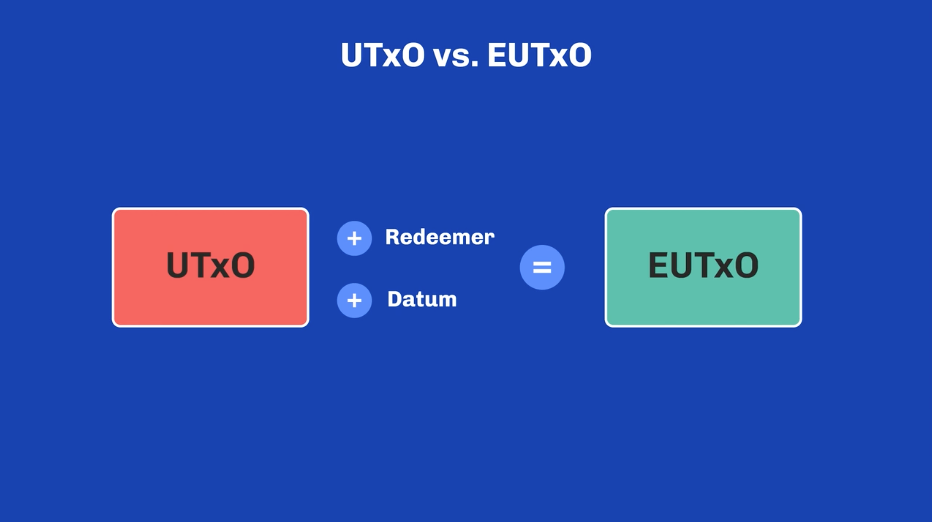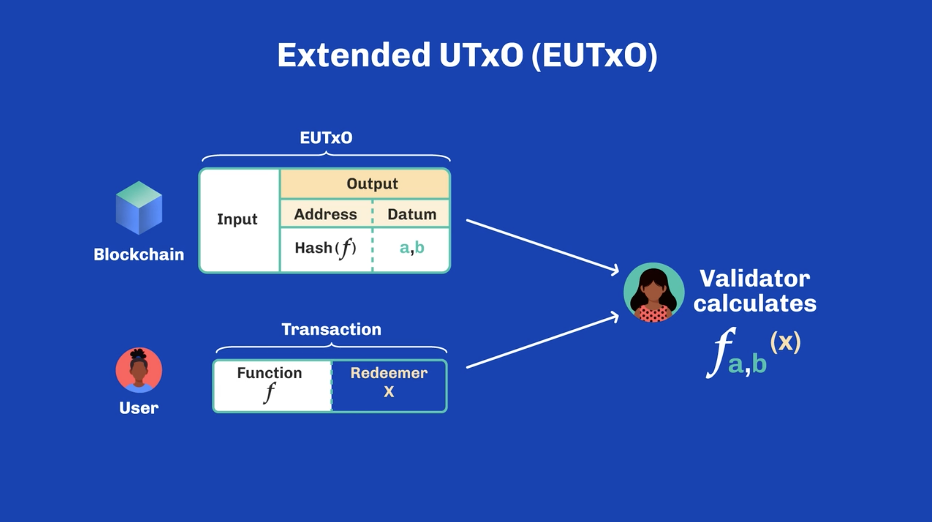The Extended UTxO (eUTxO) Model on Cardano is an advanced version of the Unspent Transaction Output (UTxO) model, which was initially used by Bitcoin. The eUTxO model enhances the original UTxO structure by supporting smart contracts and enabling more complex transactions on the blockchain. It was implemented with the Alonzo upgrade in September 2021, when Cardano introduced smart contract capabilities via its Plutus platform.

Key Features of the eUTxO Model:
- Enhanced Expressiveness: The traditional UTxO model is more restrictive in terms of programmability, whereas the eUTxO model allows for the addition of custom logic through smart contracts, supporting more complex decentralized applications (dApps) and financial services on Cardano.
- Determinism: One of the major advantages of the eUTxO model is that the outcome of transactions can be determined ahead of time. This provides greater predictability compared to the account-based model (used by Ethereum), where the outcome of a transaction can depend on external factors, such as the state of the blockchain at the time of execution.
- Concurrency and Scalability: Each UTxO in the eUTxO model can only be spent once in a single transaction, but Cardano introduced innovations like parallel execution and other scaling solutions to manage transaction throughput and concurrency issues that arise in decentralized systems.
- Transaction Validation with Plutus Scripts: In the eUTxO model, Plutus scripts are used to define the conditions under which a UTxO can be spent. This allows developers to programmatically define the logic of transactions, making it possible to implement smart contracts.
- Multiple Assets: With eUTxO, Cardano supports multi-asset transactions, meaning you can send and receive not only ADA but also other native tokens without the need for smart contracts to manage those assets.
Components of the eUTxO Model
1. Script
In the eUTxO model, a script is a piece of code that defines conditions that must be met for a UTxO to be spent. This is part of Cardano’s smart contract functionality, using Plutus, Cardano’s smart contract platform.
- Purpose: Scripts in Cardano define the rules for validating transactions. When a transaction attempts to spend a UTxO, it must meet the conditions specified by the script.
- Example: A script might require that only certain public keys can sign the transaction, or it might enforce time locks (e.g., funds cannot be spent before a specific date).
Types of Scripts:
- Plutus Scripts: These are smart contracts written in Plutus, Cardano’s native smart contract language, which allows more complex on-chain logic.
- Simple Scripts: These are simpler scripts that can enforce spending conditions such as requiring multiple signatures (multi-sig) or specific time constraints.
2. Datum
A datum is data that is attached to a UTxO and used by scripts to validate a transaction. It provides additional information required to unlock and spend the UTxO.
- Purpose: The datum acts as a “state” or input to the smart contract (script) logic. It’s stored alongside the UTxO and provides context for validating the transaction.
- Example: In a multi-party contract, the datum could store information about the current state of the contract, such as how much each party has contributed or whether certain conditions have been met.
The datum is one of the key extensions in the eUTxO model that allows for complex interactions and the execution of smart contracts. It decouples the script logic from the input data, enabling more flexibility in how contracts handle state.
3. Redeemer
The redeemer is provided by the transaction attempting to spend a UTxO and is used as input by the script to help validate the spending conditions.
- Purpose: While the datum represents the state of a UTxO, the redeemer represents the action or argument provided when a UTxO is spent. The redeemer is used to fulfill the conditions of the script.
- Example: In a voting contract, the redeemer could represent a voter’s choice, and the script would verify whether this choice is valid based on the associated datum (such as whether the voter has already voted).
In summary, the datum and redeemer work together to provide input and context for the script when validating whether a UTxO can be spent.
How the eUTxO Model Works

Here’s a simplified example of how the eUTxO model works with a script, datum, and redeemer:
- Step 1: Creation of a UTXO with a script: A transaction creates a UTxO that has a smart contract (script) attached to it. The script specifies the spending conditions, for example, that only the owner can unlock it after a certain date. Along with this, a datum is stored with the UTxO, which could include the current state of the contract.
- Step 2: Spending the UTXO: When another party attempts to spend this UTxO, they provide a redeemer as part of the transaction. The redeemer contains information relevant to the transaction, such as a signature or a voting choice.
- Step 3: Validation: The Cardano network then runs the script on the blockchain, using the datum (the state) and redeemer (the action) to check if the spending conditions are met. If the script evaluates to
True, the UTxO is spent, and the transaction proceeds. If not, the transaction is rejected.
Advantages of the eUTxO Model
- Deterministic and Parallel Execution: Unlike account-based models (like Ethereum’s), where global state changes affect multiple transactions, the eUTxO model ensures that each UTxO is independent. This enables efficient parallel processing and reduces bottlenecks.
- Better for Smart Contracts: The separation of scripts, datum, and redeemers allows for more sophisticated and flexible smart contracts, where different inputs (datum/redeemer) can result in varied outcomes.
- Enhanced Security: Since UTxOs are immutable once created and only spent through specific conditions, it reduces the potential for unintended side effects in contract execution, making the system more predictable and secure.
- Scalability: The eUTxO model allows for more scalable blockchain infrastructure, as transactions can be processed independently and in parallel, reducing contention on the global state.
Cardano’s Extended UTXO (eUTxO) Model
Cardano’s eUTxO model extends the traditional UTxO model by allowing more complex logic, such as smart contracts, and introduces additional components to support these functionalities. The main enhancements are the introduction of scripts, datum, and redeemer fields, which allow for programmable spending conditions and the execution of smart contracts.
The key differences between eUTxO and the basic UTxO model are:
- Smart contracts: The eUTxO model enables smart contract execution, which allows programmable transactions.
- Datum and Redeemer: These additional fields in eUTxO enhance the flexibility of transaction validation by allowing dynamic data inputs.
Conclusion
Cardano’s Extended UTxO (eUTxO) model brings powerful enhancements to the traditional UTxO model by enabling smart contracts and complex transaction logic. With the introduction of scripts, datum, and redeemer, Cardano provides a flexible and secure environment for decentralized applications (dApps) and programmable transactions.
The eUTxO model not only enables sophisticated use cases but also retains the scalability, security, and determinism of the original UTxO model, making it a strong foundation for building decentralized applications on the Cardano blockchain.
💡 Helpful References
IOG - The Extended UTxO Model
https://iohk.io/en/research/library/papers/the-extended-utxo-model/
IOG & Univesity of Edinburgh - The Extended UTxO Model [PDF]
https://files.zotero.net/eyJleHBpcmVzIjoxNzMyMTA3MDU0LCJoYXNoIjoiYTVhYmY4NjdiY2E2YzdkNTNjODkwNWNmZDZhYmM5MjAiLCJjb250ZW50VHlwZSI6ImFwcGxpY2F0aW9uXC9wZGYiLCJjaGFyc2V0IjoiIiwiZmlsZW5hbWUiOiJDaGFrcmF2YXJ0eSBldCBhbC4gLSAyMDIwIC0gVGhlIEV4dGVuZGVkIFVUWE8gTW9kZWwucGRmIn0%3D/333cd723bc9bef2f601b5bf331eb3bc855b48af4906c32bc26894ad9e0b62296/Chakravarty%20et%20al.%20-%202020%20-%20The%20Extended%20UTXO%20Model.pdfFrequently Asked Questions about Cardano’s eUTxO Model
1. What is the EUTXO model?
EUTXO, or Extended Unspent Transaction Output, is the model used by Cardano to manage transactions. It is an extension of the UTXO model originally used by Bitcoin, but with additional capabilities designed for smart contracts and decentralized applications (dApps).
2. How is EUTXO different from the traditional UTXO model?
The UTXO model tracks unspent transaction outputs and is simpler but lacks support for complex smart contracts. The EUTXO model extends this by allowing each transaction output to carry data (scripts or smart contracts) along with value, enabling the execution of more complex logic in transactions.
3. How does EUTXO differ from Ethereum’s account-based model?
In Ethereum’s account-based model, transactions modify account balances directly, making transactions dependent on global state. EUTXO, however, keeps transaction outputs separate, ensuring each transaction is processed deterministically, which improves security and scalability.
4. What are the benefits of EUTXO?
- Determinism: Transactions in EUTXO are deterministic, meaning that their outcomes can be predicted before they are submitted, avoiding unexpected failures.
- Parallelism: The EUTXO model allows for parallel processing of transactions, improving scalability by enabling multiple transactions to be processed simultaneously.
- Security: By separating transaction outputs, EUTXO reduces the risk of unintended side effects or conflicts between transactions.
5. How does EUTXO enable smart contracts on Cardano?
EUTXO supports Plutus scripts, which allow smart contracts to be embedded directly into the transaction outputs. These scripts can specify conditions that must be met for the funds to be spent, allowing for complex contract logic to be enforced on-chain.
6. Why does Cardano use EUTXO instead of an account-based model?
Cardano chose EUTXO because it provides better security, parallelism, and scalability compared to the account-based model. This model is particularly well-suited for Cardano’s vision of supporting complex dApps and decentralized finance (DeFi) applications.
7. How does the EUTXO model handle transaction fees?
Transaction fees in the EUTXO model are calculated before the transaction is submitted. This is possible because the execution of transactions is deterministic, meaning the resources required to process the transaction are known in advance, ensuring fair and predictable fees.
8. Can EUTXO improve scalability on Cardano?
Yes, EUTXO supports parallel transaction processing. Since each UTXO is independent, multiple transactions can be processed at the same time without needing to access shared global state, enhancing scalability.
9. What role do Plutus scripts play in the EUTXO model?
Plutus scripts are the smart contracts used in Cardano’s EUTXO model. These scripts define specific conditions (written in Haskell) that must be met for a UTXO to be spent, allowing for highly flexible and programmable transactions.
10. What challenges does the EUTXO model face?
While EUTXO offers many benefits, it also requires developers to think differently when building dApps, especially regarding how transactions and smart contracts interact. Managing UTXOs and ensuring enough UTXOs are available for multiple transactions can also introduce complexity.
11. How does EUTXO handle multi-asset support?
EUTXO natively supports multiple assets. Cardano’s multi-asset ledger allows different types of assets, such as native tokens, to be stored and transacted in UTXOs alongside ADA, making it flexible for handling multiple types of assets in the same transaction.
12. What is a ‘deterministic transaction’ in EUTXO?
A deterministic transaction means that the outcome of the transaction can be predicted before it is submitted. This is possible because the EUTXO model ensures that the conditions required to process the transaction are known and validated in advance, preventing transaction failures due to unforeseen state changes.
13. How does EUTXO enhance the security of smart contracts?
The EUTXO model enhances security by isolating transaction outputs and ensuring that each transaction is processed independently. This reduces the likelihood of unintended interactions between contracts, minimizes state manipulation risks, and ensures contracts are deterministic and predictable.
14. Does EUTXO allow for composability in dApps?
Yes, EUTXO allows for composability, meaning different decentralized applications (dApps) can interact with each other by using UTXOs as inputs and outputs. However, the design requires careful management of UTXOs to ensure that multiple dApps can interact seamlessly.

Leave a Reply